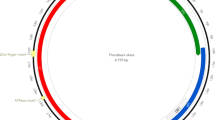Abstract
Iridoviruses are emerging pathogens that are widespread in diverse environments and hosts. Numerous members of the family Iridoviridae are known to cause severe disease in freshwater and marine organisms. Here, we report the complete genome sequence and phylogenetic analysis of iridovirus strain LPIV-ZS-2021, isolated from a small yellow croaker (Larimichthys polyactis) in China. The genome sequence comprises 110,560 bp with a G+C content of 53.42%, has 104 putative open reading frames (ORFs), and shares the highest sequence similarity with red seabream iridovirus (RSIV) isolated in Japan (98.61%). Phylogenetic analysis revealed that it belongs to RSIV clade 1. This is the first fully sequenced RSIV genome from a small yellow croaker. The host range expansion of members of the genus Megalocytivirus warrants further attention to determine its potential economic and ecological impact.


Similar content being viewed by others
References
Chen W, Cheng Q (2013) Development of thirty-five novel polymorphic microsatellite markers in Pseudosciaena polyactis (Perciformes:Sciaenidae) and cross-species amplification in closely related species, Pseudosciaena crocea. Biochem Syst Ecol 47:111–115
Eaton HE, Ring BA, Brunetti CR (2010) The genomic diversity and phylogenetic relationship in the family Iridoviridae. Viruses 2:1458–1475
Hick P, Becker J, Whittington R (2016) Iridoviruses of fish. Aquaculture virology. Elsevier, Amsterdam, pp 127–152
Huang Y, Huang X, Liu H, Gong J, Ouyang Z, Cui H, Cao J, Zhao Y, Wang X-J, Jiang Y, Qin Q (2009) Complete sequence determination of a novel reptile iridovirus isolated from soft-shelled turtle and evolutionary analysis of Iridoviridae. BMC Genomics 10:224
İnce İA, Özcan O, Ilter-Akulke AZ, Scully ED, Özgen A (2018) Invertebrate Iridoviruses: a glance over the last decade. Viruses 10:161
Johnson AJ, Pessier AP, Wellehan JF, Childress A, Norton TM, Stedman NL, Bloom DC, Belzer W, Titus VR, Wagner R (2008) Ranavirus infection of free-ranging and captive box turtles and tortoises in the United States. J Wildl Dis 44:851–863
Kurita J, Nakajima K (2012) Megalocytiviruses. Viruses 4:521–538
Li Y, Han Z, Song N, Gao TX (2013) New evidence to genetic analysis of small yellow croaker (Larimichthys polyactis) with continuous distribution in China. Biochem Syst Ecol 50:331–338
Li Z, Shan X, Jin X, Dai F (2011) Long-term variations in body length and age at maturity of the small yellow croaker (Larimichthys polyactis Bleeker, 1877) in the Bohai Sea and the Yellow Sea, China. Fish Res 110:67–74
Papp T, Marschang RE (2019) Detection and characterization of invertebrate iridoviruses found in reptiles and prey insects in Europe over the past two decades. Viruses 11:600
Shi CY, Jia KT, Yang B, Huang J (2010) Complete genome sequence of a Megalocytivirus (family Iridoviridae) associated with turbot mortality in China. Virol J 7:159
Stöhr AC, López-Bueno A, Blahak S, Caeiro MF, Rosa GM, Matos APAd, An M, Alejo A, Marschang RE (2015) Phylogeny and differentiation of reptilian and amphibian ranaviruses detected in Europe. PLoS ONE 10:e0118633
Whittington RJ, Becker JA, Dennis MM (2010) Iridovirus infections in finfish—critical review with emphasis on ranaviruses. J Fish Dis 33:95–122
Williams T, Bergoin M, van Oers MM (2017) Diversity of large DNA viruses of invertebrates. J Invertebr Pathol 147:4–22
Funding
This study was supported by grants provided by the Key Research and Development Program of Zhejiang Province (2020C02015), the Second Batch of Zhoushan City Special Funds for the Development of Modern Fishery (2020)21, and the National Key Research and Development Project (2020YFD0900803).
Author information
Authors and Affiliations
Contributions
Conceptualization: XWJ and LQZ. Methodology: WGS, XJJ, XW, and CHX. Software: WGS, BAX. Writing—review and editing: LQZ. Funding acquisition: WGS, XJJ, and XWJ
Corresponding author
Ethics declarations
Conflict of interest
The authors declare that they have no conflict of interest.
Additional information
Handling Editor: Kalpana Agnihotri .
Publisher's Note
Springer Nature remains neutral with regard to jurisdictional claims in published maps and institutional affiliations.
Supplementary Information
Below is the link to the electronic supplementary material.
Rights and permissions
About this article
Cite this article
Wang, G., Xu, W., Cheng, H. et al. Complete genome sequence and phylogenetic analysis of red seabream iridovirus isolated from a cage-cultured small yellow croaker (Larimichthys polyactis) in China. Arch Virol 167, 2085–2088 (2022). https://doi.org/10.1007/s00705-022-05508-5
Received:
Accepted:
Published:
Issue Date:
DOI: https://doi.org/10.1007/s00705-022-05508-5




